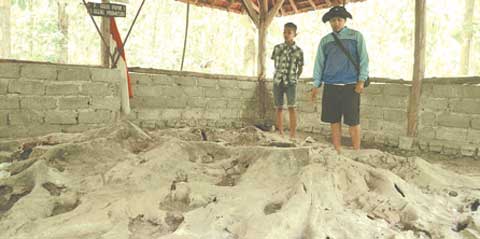MASJID Agung Demak yang dibangun Raden Fatah dan dibantu para wali pada tahun 1479 Masehi oleh sebagian rakyat dipercayai memiliki keterkaitan dengan Bumi Blambangan. Dari empat tiang (soko guru) kayu jati masjid itu, salah satunya berasal dari Alas Purwo, Banyuwangi.
Empat tiang yang dipancangkan di Masjid Agung Demak itu dipasang sesuai penjuru mata angin. Tiang di barat laut didirikan Sunan Bonang, di barat daya karya Sunan Gunung Jati, di bagian tenggara buatan Sunan Ampel, dan yang berdiri di timur laut karya Sunan Kalijaga.
“Pohon jati yang di gunakan Sunan Kalijaga untuk tiang masjid itu konon berasal dari Alas Purwo,” ujar Trimo, 62, salah seorang sesepuh Desa Kalipait, Kecamatan Tegaldlimo. Berdasar cerita turun temurun yang ber kembang di masyarakat dan hasil penerawangan alam gaib, tunggak jati (Jati Papak) atau bekas potongan pohon yang digunakan Sunan Kalijaga itu tidak terlihat secara kasat mata.
Bahkan, hanya orang dengan hatiyang bersih bisa diperlihatkan letak tunggak pohon jati tersebut. Ada beberapa versi mengenai Situs Jati Papak itu. Satu versi menyebutkan pohon jati di Alas Purwo itu sampai Demak dibawa sejumlah katak melalui jalur laut.
Versi lain, pohon jati yang diambil dari Alas Purwo itu berpindah langsung menjadi penopang kekuatan soko tatal (dari serpihan patahan kayu) yang diikat Sunan Kalijaga. “Sepintas tampak luar memang soko tatal, tapi sejatinya itu pohon jati besar,” cetusnya.
Sejarah kayu yang dibuat soko guru (tiang) Masjid Agung Demak berasal dari alas Purwo itu sudah lama, terutama bagi masyarakat yang tinggal di sekitar hutan Alas Purwo. Konon, pohon jati itu selain digunakan sebagai tiang di Masjid Agung Demak, bagian pucuk pohon jati ditanam di Pura Puncak Jati, Jembrana, Bali.
Tunggak pohon jati yang kini dikenal Situs Jati Papak itu kali pertama ditemukan sekitar tahun 1995 oleh seorang pejabat KPH Perhutani Banyuwangi Selatan yang melihat sebuah sinar. Dengan berbagai cara dan melalui penerawangan gaib, warga sekitar mencari sumber sinar tersebut.
Setelah ditemukan, ternyata sumber itu berasal dari sebuah papak atau tunggak bekas potongan kayu jati berukuran besar. “Dulu itu permukaan tunggak jati rata dan mengkilat karena sering digunakan semedi,” ujarnya. Seiring berjalannya waktu, kondisi situs Jati Papak tak lagi rata dan mengkilap.
Bahkan, permukaannya sudah tidak bisa digunakan duduk bersila. Baru tahun 1997 Jati Papak mulai dipelihara dan dilestarikan menjadi situs. Letak Situs Jati Papak berada di tengah hutan, masuk kawasan TNAP. Lokasi itu berjarak sekitar 15 kilometer dari pusat kota Kecamatan Tegaldlimo, dan berjarak sekitar 76 kilometer dari Pemkab Banyuwangi.
Sejak ditemukan dan ditetapkan menjadi situs, Jati Papak sering didatangi warga. Dia antara pengunjung juga banyak yang bermalam. Ironisnya, mereka ada yang pulang sambil memotong bagian dari tunggak tersebut. Akibat banyak tangan jahil itu, Situs Jati Papak yang dulu mengilat dan rata, kini sudah tak berbentuk.
“Bentuknya sudah banyak yang berubah,” terang Trimo. Merasa prihatin peninggalan sejarah itu rusak, pada tahun 2013 Paguyuban Peduli Lingkungan Manik Purwa Buwana memberikan pagar pembatas dan memberi atap menyerupai pondok pesarean seluas sekitar 25 meter persegi.
Di tempat itu juga diberi papan peringatan berisi larangan agar tidak mengambil, mengubah, dan merusak Jati Papak. (radar)






